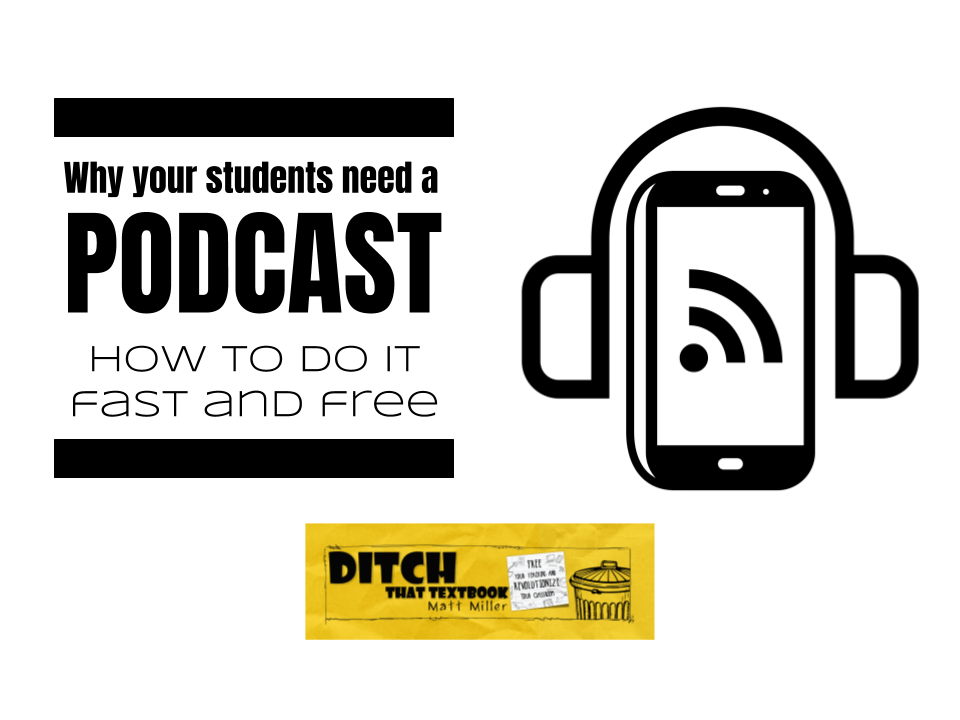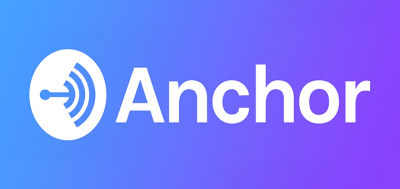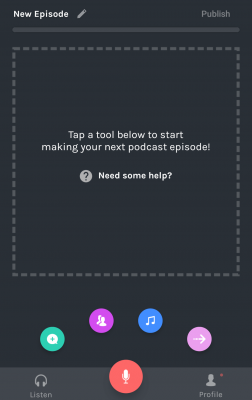

Podcasts are growing in popularity. By letting your students create one, they get an authentic audience and get a voice in a big way. It’s easy and free.
Podcasts can serve a crucial role in preparing your students for the future and helping their learning to be meaningful.
Sound like things you’re looking for? You’re in the right place.
Plus, you (and your students) can create them for FREE in very little time.
A podcast is kind of like a radio show in your pocket. Podcasts are audio recordings that can be downloaded to a phone, played on a computer or streamed on a device.
Many of them come out on a set schedule: weekly, daily, once every two weeks, etc.
The biggest power of podcasts, in my opinion:
They buy you time.
You can learn while driving, cleaning the house, gardening, jogging, etc. Video is very popular, but it can’t make that claim, and neither can text reading. They both require your undivided attention.
And as smart speakers — Amazon Echo (Alexa), Google Home and Apple HomePod — grow in popularity, there are more access points for podcasts and other audio mediums.
Because it all leads to meaningful learning.
Reason 1: Students do assignments for teachers every day. They turn them in for teachers to see.
If they’re creating for that audience of one (the teacher), do we always get their best work?
Not always.
What if we gave their work a greater reach? What if they knew that people they knew — and people they’d never meet — were benefitting from their work?
We’re more likely to get students’ best work when they have an audience that’s important to them.
Reason 2: Our world is craving smart, responsible problem solvers and critical thinkers.
But all of that problem solving and critical thinking doesn’t matter if our leaders can’t articulate their vision.
If we want our students to be great speakers and communicators, we have to invest classroom minutes in it NOW. If they’re going to advocate for change or help others envision an idea, out students — now and in the future — need good communication skills.
They need to develop their voice. And now is the time to do it.
Even if you aren’t a podcast fanatic (and statistically, you probably aren’t), you can still help your students develop their voices for an authentic audience with a podcast.
For free. In just a few minutes each day.
Imagine a class podcast …
Imagine a student podcast for special projects or Genius Hour …
 Anchor (anchor.fm) is a FREE podcast platform.
Anchor (anchor.fm) is a FREE podcast platform.
The terms of use for Anchor are 13+, so classes with students younger than that could create a class podcast that’s supervised and moderated by the teacher who IS 13+.
There’s some one-time set-up to do before the podcast is ready to go …

From the Anchor app (pictured), you can record audio, take call-in interviews, add music, insert sound effects and more. (Anchor.fm screenshot)
Once your podcast is all set up, here’s what you’ll do to record:
Some things to consider when using Anchor:
Parents. So often, parents are craving a connection to the classroom. They want to know what their kids are learning. They want some “insider information” when they ask their child, “What did you do in school today?” And when their kids do something cool, they LOVE to brag about it and share it with others. (I know this because I do it with my kids, too!)
Grandparents and other relatives. These relatives might not see their little loved ones that often. Knowing what they’re up to and hearing their voices might delight them.
Other classes. You know that teachers love getting inspiration from other teachers. Plus, other classes may listen to your class’s podcast to learn from others their age.
Anyone in the world. This is possible when your podcast is available on these popular podcast platforms. Podcasts let you help and connect with people you’ll never meet in countries you’ll never visit.
With the Google Teacher Tribe podcast I create with Kasey Bell, we get contacted regularly from people all over the United States and in other countries with questions and comments about the podcast. We’re CONSTANTLY blown away by the reach of our podcast.
Producing a podcast on Anchor is FREE and doesn’t take much time to set up.
It can give your students’ learning an authentic audience. Plus, it can give them an opportunity to reflect on and think about what they’re learning on a different level.
When they teach others, it gives the student a new, deeper perspective on their learning.
You have the tools. You have the know-how.
Give your students a big voice!
Note: I have no relationship with Anchor. I receive no compensation — monetary or otherwise — for mentioning Anchor in this post. It’s just a service I use and love and think could be a great asset to teachers and their students!
How could you use a podcast in the classroom? If you’ve done some classroom podcasting, what has been your experience? Share in a comment below!
For notifications of new Ditch That Textbook content and helpful links:
Interested in having Matt present at your event or school? Contact him by e-mail!
Matt is scheduled to present at the following upcoming events:
[getnoticed-event-table scope=”upcoming” max=”15″ expanding=”false”]

Session expired
Please log in again. The login page will open in a new tab. After logging in you can close it and return to this page.
This sucks. It was not helpful at all. I did an autogenerated name, and it chose to name the the stupid gay little faggot podcast.
I really want to try out podcast but I was just thinking how, as I teach Math.
You could do- math in our world today, interview people using math in their jobs, offer tutoring or a math problem of the day, state testing help, true crime where math made a difference, that’s off the top of my head 🙂
Hi,
Thank you so much for this info. I want to start a podcast with my students but cant really figure out how they can all upload their recordings to my user on Anchor. Could you give some more details on how thay can all collaborate on one podcast?
Tanks in advance!
I have this same question! Hopefully someone will help us out.
Hi! Were you able to use it on your class? How did it go? TIA for answering!
I plan on pairing up students and each group is responsible for a different episode.
[…] Why your students need a podcast: How to do it fast and free – https://ditchthattextbook.com/why-your-students-need-a-podcast-how-to-do-it-fast-and-free/ […]
[…] Read: Why your students need a podcast: How to do it fast and free […]
[…] Miller, M. (2018, February 28). Why your students need a podcast: How to do it fast and free. Ditch That Textbook. Retrieved from https://ditchthattextbook.com/why-your-students-need-a-podcast-how-to-do-it-fast-and-free/ […]
[…] Miller, M. (2018, February 28). Why your students need a podcast: How to do it fast and free. Retrieved May 23, 2020, from https://ditchthattextbook.com/why-your-students-need-a-podcast-how-to-do-it-fast-and-free/ […]
[…] Why your students need a podcast: How to do it fast and free […]
I am so excited to have found your recommendation for Anchor. I want to do a podcast in my 10th grade English class. We will be studying the Holocaust and reading “Night” by Elie Wiesel. I always do a research paper, but I want to turn that paper (with some adjustments) into a podcast! Thank you so much!!
I’m curious if you tried it, Sherrie, and how it went. My 5th graders write biographies on various famous people and I’d be interested in turning their papers into a podcast. Ed- would you have any suggestions for this? TIA!